|
|
|
|
Panther Ausf. A Late
Meng, 1/35 scale
Reviewed by Brett Green

Summary
| Stock Number and Description | Meng Kit No. TS-035 - Panther Ausf. A Late |
| Scale: | 1/35 |
| Media and Contents: | 427 parts in primer red coloured plastic; 672 parts in black plastic; 14 parts in clear; 41 photo-etched parts on two frets; two lengths of twisted metal cable; markings for six vehicles. |
| Price: | TBA |
| Review Type: | First Look |
| Advantages: | Innovative approach; lovely rolled armour plate and cast texture; many options; high level of detail; stowage such as spare wheels and tracks, unditching beams and jerry cans included; separate aftermarket items including workable track links with operating metal torsion bars and three different styles of Zimmerit decals. |
| Disadvantages: | |
| Recommendation: | Meng's 1:35 scale Panther Ausf. A Late is a high quality package. The level of detail is impressive, Meng has supplied many useful options and plenty of stowage yet basic construction of the hull and the turret does not look too daunting. The kit breakdown suggests that other versions will be available too. The track links will be time consuming to clean up, but their assembly should be within the grasp of any moderately experienced modeller. If you crave fully workable suspension, you are in luck. Meng has produced a fully workable suspension set (available separately) including flexible metal torsion bars and individual link tracks held in place using metal pins. As far as I am aware, there is virtually no way to avoid Zimmerit coating on a late Panther Ausf. A. Once again, Meng has you covered here with four different Zimmerit pattern decal sheets, all available separately. We have been overdue for a state-of-the-art 1:35 scale Panther A, and it looks like Meng has now delivered! |
B a c k g r o u n d
The Panther was a German medium tank deployed during World War II on the Eastern and Western Fronts in Europe from mid-1943 to its end in 1945. It had the ordnance inventory designation of Sd.Kfz. 171.
The Panther was intended to counter the Soviet T-34 and to replace the Panzer III and Panzer IV. Nevertheless, it served alongside the Panzer IV and the heavier Tiger I until the end of the war.
It is considered one of the best tanks of World War II for its excellent firepower and protection, although its reliability was less impressive.

The Panther was a compromise. While having essentially the same engine as the Tiger I, it had more efficient frontal hull armour, better gun penetration, was lighter and faster, and could traverse rough terrain better than the Tiger I.
The trade-off was weaker side armour, which made it vulnerable to flanking fire.
The Panther proved to be effective in open country and long range engagements, but did not provide enough high explosive firepower against infantry.*
*Historical summary courtesy of Wikipedia https://en.wikipedia.org/wiki/Panther_tank
The Panther Ausf. A in 1:35 Scale
There have been a number of Panther Ausf. A kits available in 1:35 scale, dating back to Tamiya's kit from 1976. This kit was typical of its era, with a hull modified for motorisation and cable remote control, and suffering a number of accuracy and dimensional problems. A Jagdpanther based on the running gear of this kit was also available.
Although Dragon released a number of Panther Ausf. F and G kits in the mid to late 1990s, their first new tool Ausf. A was launched in 2002. This was considered a landmark kit in its day but it is beginning to show its age now.
F i r s t L o o k
Meng has now entered the Panther market with their brand new 1:35 scale Ausf. A Late Version.
The kit comprises 427 parts in primer red coloured plastic, 672 parts in black plastic, 14 parts in clear, 41 photo-etched parts on two frets, two lengths of twisted metal cable and markings for six vehicles.
Although the total number of parts may appear intimidating, it should be noted that the nearly 700 black parts are all destined for the tracks with another 92 optional ice cleats on the red sprues. You can also subtract a number of optional parts, bringing the actual number of plastic parts used for the kit (minus the tracks) down to something close to Tamiya's recent Ausf. D and fewer than Dragon's Ausf. A. Of course, the two photo-etched frets will lend more detail to Meng's plastic parts.

The first two aspects of the kit that caught my eye when looking through the sprues were the hull peppered with openings, and the skeletal framework of the turret. Both of these features suggest that Meng is planning different versions of the Panther in future.

Assembly starts with the running gear and lower hull. The road wheels, idler wheels and drive sprockets are attached via polythene caps, which should make painting the layered suspension arrangement a bit easier.
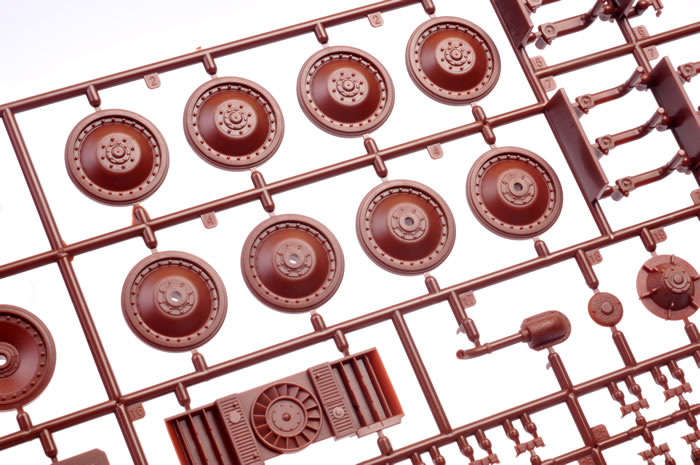
The lower hull is made up from a flat pack of sides, rear and bottom. This is made rigid by two braces fitted to the inside. Suspension swing arms are separate and designed to be glued in place.
The individual track links are made up from three parts each - one remarkably cleanly moulded main link (no ejector pin marks visible at all) and two individual hollow guide horns. Optional ice cleats are also included. Each main link is connected to the sprue via six attachment points, with the guide horns attached by one each. The extra time you spend removing the links will be compensated by the lack of ejector pin circle cleanup.
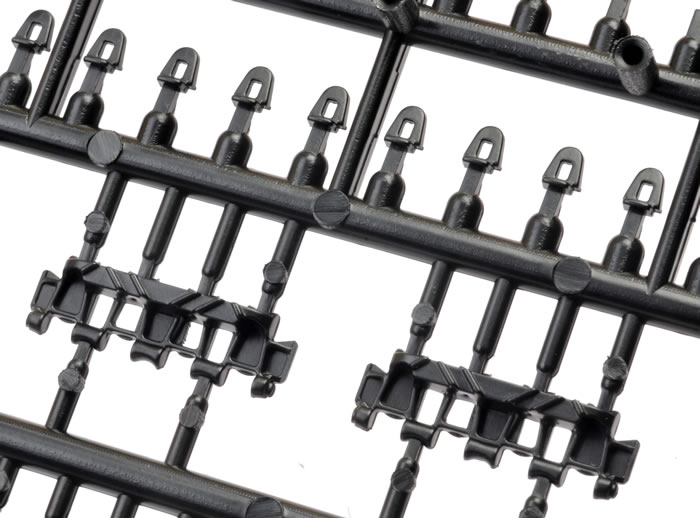
The links are designed to be assembled on the included jig, moulded in a ski-jump shape. The links are a nice firm press fit and are designed to be glued together.
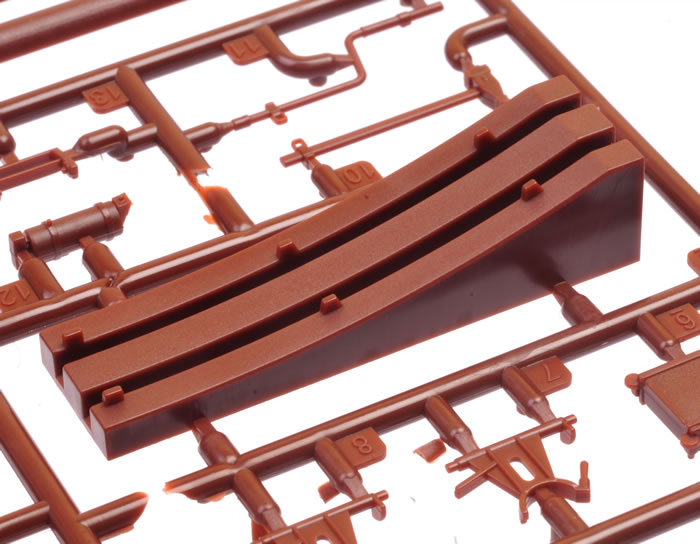
Alternative exhausts are included - one three-pipe exhaust plus one single pipe or two single pipes.
The rolled armour plate texture on the separate hull front and sides is very authentic. These panels are glued over the top of the main hull part.
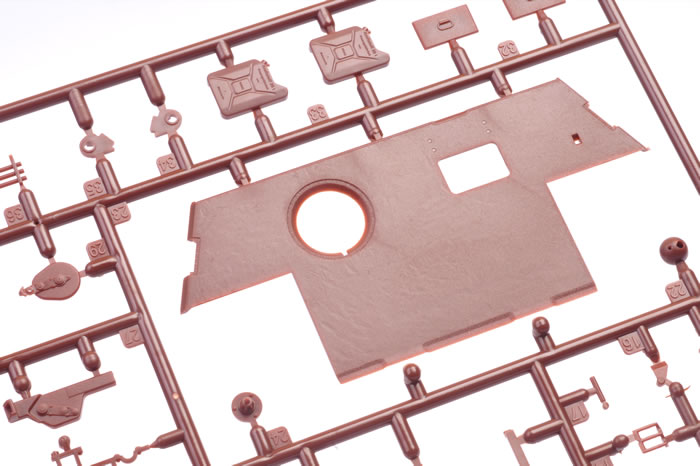
Cast texture elsewhere is equally good.
The driver's visor and the upper hatches may be posed open or closed. Another interesting option is a plug on a chain for the front machine gun position. The gun crutch may be posed raised or lowered. Early-style full front fenders plus feeler poles are provided as options too, as are two styles of gun cleaning rod tube..
Fan and engine detail is supplied on two individual parts that are glued in place underneath the engine deck grilles. Photo-etched covers are included for the engine deck grilles.
Side skirts are included as an option, and track hangers may be mounted on the sponson covers. Individual bolt heads are offered for the top of the track hanger rack. Spare tracks and pins are included too.
Stowage includes two styles of water bucket, two spare road wheels, a number of jerry cans, engine deck stowage box, and two unditching beams with nice wood texture.
One of the photo-etched frets has the star aerial of the Befehlspanther command vehicle too.
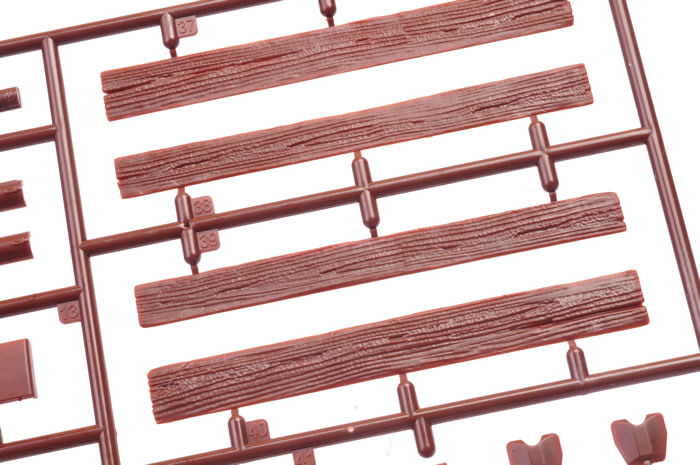
The individual turret panels are designed to be glued to the skeletal framwork.
The gun is moulded with basic breech detail - sufficient to satisfy if glimpsed through the open turret hatch. The gun barrel is turned metal with a three-piece plastic muzzle brake.
Clear parts are included for the vision blocks.
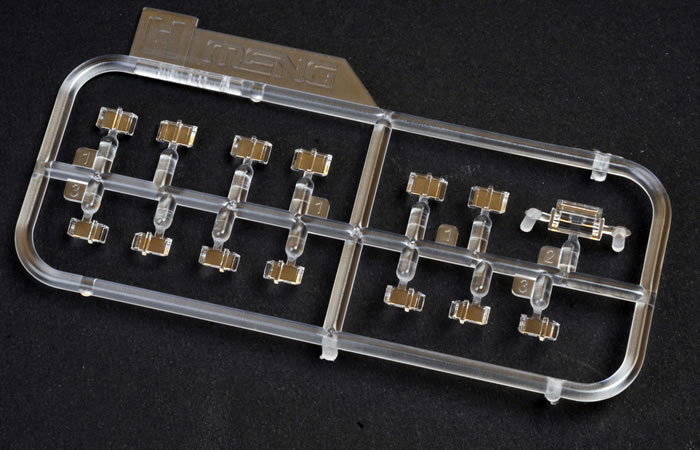
Two styles of MG 34 machine gun are offered, plus an ammo belt and a detailed mount with spent shell bag.
Markings are supplied for six vehicles, all with white numbers. One captured Soviet scheme is offered, plus five German schemes in standard mid to late-war three colour camouflage.
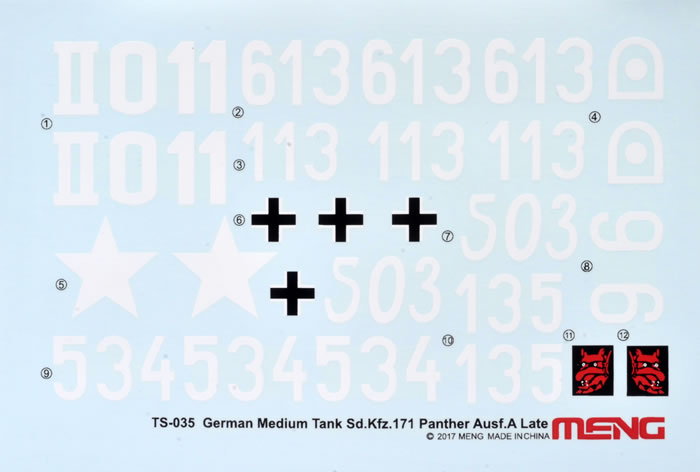
Decals are well printed.
C o n c l u s i o n
Meng's 1:35 scale Panther Ausf. A Late is a high quality package. The level of detail is impressive, Meng has supplied many useful options and plenty of stowage yet basic construction of the hull and the turret does not look too daunting. The kit breakdown suggests that other versions will be available too.
The track links will be time consuming to clean up, but their assembly should be within the grasp of any moderately experienced modeller.
If you crave fully workable suspension, you are in luck. Meng has produced a fully workable suspension set (available separately) including flexible metal torsion bars and individual link tracks held in place using metal pins.
As far as I am aware, there is virtually no way to avoid Zimmerit coating on a late Panther Ausf. A. Once again, Meng has you covered here with four different Zimmerit pattern decal sheets, all available separately.
We have been overdue for a state-of-the-art 1:35 scale Panther A, and it looks like Meng has now delivered!
Thanks to Meng for the sample
Text and Images by Brett Green
Page Created 3 December, 2017
Page Last Updated
4 December, 2017



















